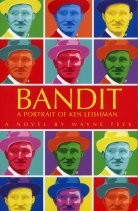Bandit: A Portrait of Ken Leishman
In the true crime novel Bandit: A Portrait of Ken Leishman, writer Wayne Tefs delves into the life of infamous criminal Ken Leishman.
Tefs explores Leishman’s past, including his troubled youth, and weaves it into the latter years of his life.
Leishman is known for the astonishing 1966 gold heist that took not only the RCMP, but all of Canada, by surprise.
Tefs explains and opens the gentleman bandit’s mind to us as to what he may have been thinking and trying to accomplish in his felonious career and, while doing this, Tefs blurs reality and fiction - not unlike Jerry Stahl’s I Fatty, the fictionalized autobiography of Fatty Arbuckle.
Tefs takes a direct delineation of Ken Leishman’s story and injects what he may be thinking at critical points in his life, from growing up in post-Second World War Canada to the abandonment of his father as a child and his subsequent return in Leishman’s teenage years.
From growing up with tough-love grandparents to seeing opportunity and dreaming of the “big life,” Leishman is constantly trying to do better than what he was left with.
The only role models he finds are the actors of the time, such as Humphrey Bogart and Gary Cooper. In all the movies he watches growing up he sees them as tough (but smart), sharply dressed and well groomed.
Ken finds redemption in these movies and Tefs gains insight as to perhaps why the thief was the way he was.
Sporting a fedora, the anti-hero was always well dressed and polite to everyone - a gentleman.
Leishman wanted prominence, prestige and wealth. This wasn’t because he thought he was better than everybody else, it was about saving his family from the hardships he endured as a child (Leishman himself had a wife and seven kids). He wanted to pull off a heist that would take care of himself and his family and leave that life behind.
The gold heist from the Winnipeg airport in 1966 intended to do just that.
Unfortunately, Leishman’s heist did not pan out and the people involved were caught, leaving Leishman to resort to desperate measures.
Throughout the book, I could not help but cheer for Ken Leishman.
Tefs’s interpretation of events and his ability to mesh fiction with non-fiction left me wondering what was true and what was not, allowing my imagination to run with Leishman and feel like I had been there through it all.
Published in Volume 66, Number 16 of The Uniter (January 18, 2012)








